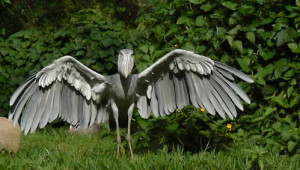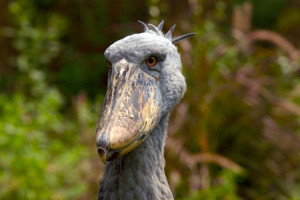Shoebill Bird Facts
By Dominic Couzens – Shoebills are found across a belt of central East Africa that stretches from South Sudan to Zambia, with a reputed outpost in Botswana. Throughout this area they are exceedingly localized, occurring only in large, rich, dense swamps.
The vegetation in these habitats is often taller than a human, with innumerable small ditches and secret corners where even large birds can feed in seclusion. As a result, the shoebill – both shy and living at low densities – is almost legendarily hard to see, especially when breeding. Even in Zambia’s Bangweulu Swamps, which may be the best location in the world for spotting the species, it can disappear into the heart of the 10,000km2 wilderness for months.
And that, of course, makes it the perfect subject for a groundbreaking documentary on Africa’s less well-known wildlife.
DESIGNER DINO-BIRD
 The shoebill is a peculiar-looking bird with a singular ecology. What sets it apart is its bulbous and capacious bill, 23cm long and 10cm broad (its scientific name, Balaeniceps rex, means literally ‘king whale-head’).
The shoebill is a peculiar-looking bird with a singular ecology. What sets it apart is its bulbous and capacious bill, 23cm long and 10cm broad (its scientific name, Balaeniceps rex, means literally ‘king whale-head’).
The bill’s shape is often compared to a Dutch dog, though you would be suspicious of anybody sporting footwear with such a vicious spike at one end – and you’d be still more worried about the fact that the edge of the bill is razor sharp, keen enough to decapitate a very large fish.
The fit of the mandibles endows the shoebill with a decidedly sinister ‘smile’ which, combined with maniacally staring yellow eyes and the small crest on the head, creates the impression that you could be seeing one of the recently unearthed ‘dino-birds’.
The bill is a perfect adaptation for catching the large fish that constitute the bird’s staple diet. One of the shoebill’s favourite prey is the African lungfish, a primitive species that must regularly break the surface to gulp air – one strange African icon eaten by another.
The shoebill also hunts catfish and tilapias – indeed anything, really, of the right size. Though ‘hunf implies a certain degree of activity -instead the shoebill is famously deliberate and slow-moving, standing at the edge of the water in a statuesque pose (it has been recorded staying completely motionless for over half an hour) yet ready to strike.
From a state of near-stillness the mighty bird collapses forward, head and bill thrust down, wings raised, feet unmoved. Ifs a splash-and-grab raid, the bill’s hook puncturing the fish’s body. A flurry of struggle usually follows, as a shoebill often takes some 10 minutes to regain its balance. Its collapse is so complete, and it fishes in waters that are so choked with underwater vegetation, that the bird often has to disentangle its own body from the greenery before it can swallow its prey.
“We particularly wanted shots of a shoebill hunting, since it had hardly ever been filmed before,” says Alex Lanchester, the BBC’s director on location. “We found one trying to catch catfish – but I think it was a juvenile, because it wasn’t a very good fisher. It kept missing.”
A VARIED DIET
 Maybe that individual had also missed its vocation: the shoebill hunts many species besides fish. Prey items recorded include water snakes, monitor lizards, turtles and, remarkably, young crocodiles (apparently, adult crocodiles sometimes reciprocate and eat shoebills). A tantalizing observation from 1961 suggested that shoebills in the Bangweulu Swamps might even eat newborn black lechwe, a type of antelope that feeds out on the plains during daylight but frequently hides in dense swampland by night. However, in reality even newborn lechwe are probably too big – any shoebill that ate one is likely to still be suffering indigestion.
Maybe that individual had also missed its vocation: the shoebill hunts many species besides fish. Prey items recorded include water snakes, monitor lizards, turtles and, remarkably, young crocodiles (apparently, adult crocodiles sometimes reciprocate and eat shoebills). A tantalizing observation from 1961 suggested that shoebills in the Bangweulu Swamps might even eat newborn black lechwe, a type of antelope that feeds out on the plains during daylight but frequently hides in dense swampland by night. However, in reality even newborn lechwe are probably too big – any shoebill that ate one is likely to still be suffering indigestion.
Shoebills do, however, benefit in other ways from the presence of large mammals in their territory. At Bangweulu, groups of hippopotamus -elsewhere, elephants – plough furrows through the dense swamplands that are otherwise choked with vegetation, and these become relatively open thoroughfares for fish and other shoebill prey. The birds perch on the floating vegetation beside these channels, often up to their bellies.
Such is the impenetrable nature of core shoebill habitat that this unmistakable species was unknown to science until the 1850s, though its natural range exceeds 2 million km2. If finding this elusive bird was a big ask for the BBC crew, its main objective was harder still: to film a nest (and if you think an adult shoebill looks discomfiting, you should see a chick). In the best tradition of blue-chip natural-history filmmaking, a suitable nest was discovered only at the very end of the month-long expedition, when it seemed that all was lost. But the effort proved worthwhile, and the team filmed some extraordinary behaviour.
“The nests are huge mounds of vegetation, built right at the water’s edge,” says Alex. They can reach 3m across and, reputedly, support the weight of a human. “Eventually we found one with two chicks inside, vastly different in size. And what we filmed was horrible to watch.”
It turned out that the youngsters weren’t exactly getting on. In each nest, two chicks hatch up to five days apart, so one is much smaller than the other, and open to abuse.
SINISTER SIBLING RIVALRY
“On several occasions the older chick attacked its younger sibling, drawing blood,” Alex reports. “It would drive its sibling over to the side of the nest. When the parent arrived it favoured the larger chick, shading it from the sun with its wings and giving it water from its bill. The younger chick was forced out into the heat, and died slowly.”
This is a classic case of brood reduction, in which a bird with a limited food supply always favours its oldest chick, ensuring that at least one of the brood survives. The second chick is insurance if the first chick is lost, and a bonus in years of plenty.
It’s pretty brutal. But with a modern-day dino-bird, you might expect a bit of blood and guts.
